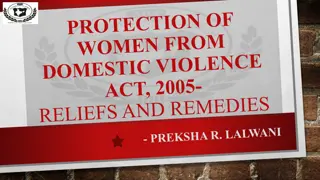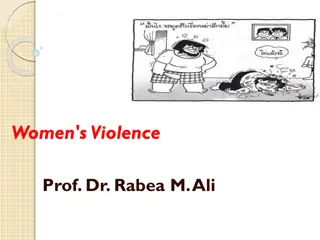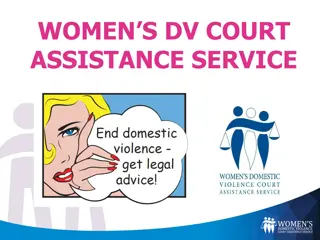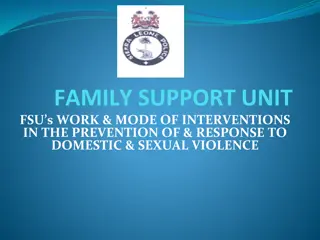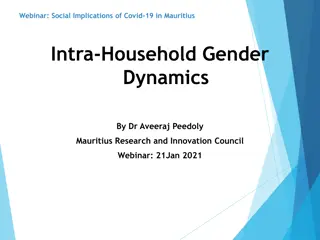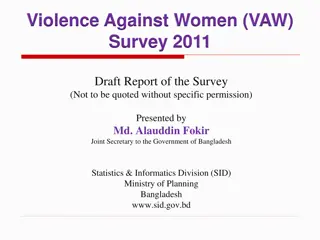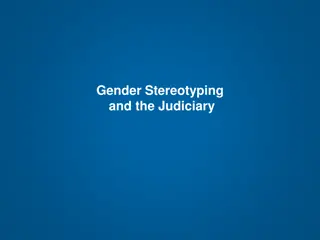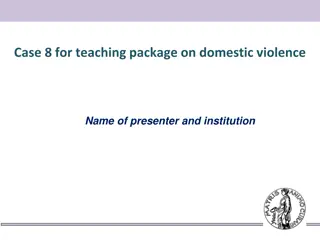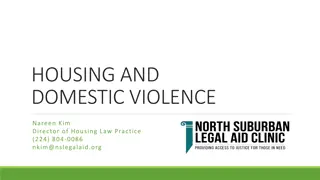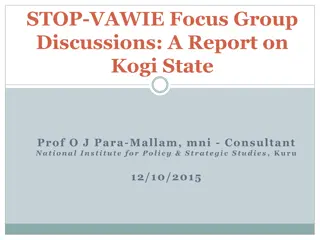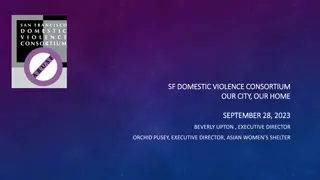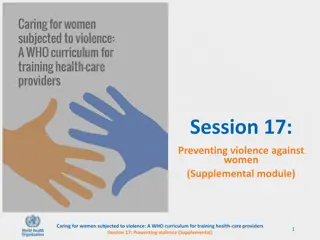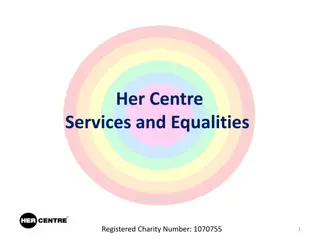Study on Domestic Violence Against Women in Vietnam
The study on domestic violence against women in Vietnam highlights the context, methodology, questionnaire adaptation, and identification of violence types. The research includes quantitative and qualitative components to gather data on prevalence, causes, consequences, coping strategies, risk factors, and protection factors. The study reveals the gap between theory and practical implementation in laws on gender equality and domestic violence, emphasizing the importance of specific plans and measures to prevent and combat domestic violence.
Download Presentation

Please find below an Image/Link to download the presentation.
The content on the website is provided AS IS for your information and personal use only. It may not be sold, licensed, or shared on other websites without obtaining consent from the author. Download presentation by click this link. If you encounter any issues during the download, it is possible that the publisher has removed the file from their server.
E N D
Presentation Transcript
International Seminar on Gender Statistics National Study National Study on Domestic Violence against Women Domestic Violence against Women Sharing Experience from Viet Nam Sharing Experience from Viet Nam on Incheon, Republic of Korea, 12-14 November 2013 Nguyen Thi Viet Nga General Statistics Office of Vietnam
1. Context before the study VN Gov. ratified several core international human rights treaties, including those on civil and political rights (ICCPR), economic, social and cultural rights (ICESCR), racial discrimination (CERD), gender equality (CEDAW) and child rights (CRC) The 2002 CPRGS identified gender inequality and domestic violence as obstacles to development. The Central Committee of the Communist Party issued Directive in 2005, which states that the government should have in place specific plans and measures to prevent and combat domestic violence . 2 laws on GE and DV but there is still a gap between the theory and practical implementation at all levels. Data on VAW from reporting system is not reliable, some small-scale quantitative and qualitative study could not show a national picture of VAW 2
2. Methodology and sample Quantitative component : 4838 women in 63 provinces in Vietnam which representative for 6 regions in Vietnam To provide data on prevalence, causes, consequences, coping strategies, risk and protection factors .... Method: Population-based household survey face to face interviews with women using structured questionnaire. Sampling: Only one woman per household. Qualitative component: 90 In-depth interviews and 12 Focus Group Discussions (in 3 provinces ) The research was initiated since June 2009 and the national report was launched in Nov 2010 3
3. Questionnaire adaptation Review of the WHO Multi-country Study survey questionnaire by the research team (version 10) Translation of the questionnaire into Vietnamese from English Sharing of the questionnaire with relevant authorities, experts, and other stakeholders working on gender in Viet Nam Discussions, adaptation of the questionnaire Pre-field testing of the questionnaire in Ha Noi and Tien Giang. Finalization of the questionnaire (also during the training course). 4
4. Identification of type of violence 4. Identification of type of violence The word violence was not used, but a range of behaviour-specific questions (acts) Women aged 18 - 60 years old were asked whether they have ever experienced behaviour-specific acts related to: Physical violence Sexual violence Emotional abuse Economic abuse The term ever married and husband includes 1% of women who ever have other partners (dating/cohabiting).
Physical violence by husband Physical violence by husband Has your husband ever..... Slapped or threw something at you that could hurt you? Pushed or shoved you or pulled your hair? Hit with his fist or with something else that could hurt you? Kicked, dragged or beat you up? Choked or burnt you on purpose? Threatened to use or actually used a gun, knife or other weapon against you?
S Sexual exual v violence by iolence by husband husband Were you ever physically forced to have sexual intercourse when you did not want to? Did you ever have sexual intercourse you did not want because you were afraid of what he might do? Ever force you to do something sexual that you found degrading or humiliating? Ever force you to have sex with another person?
Emotional abuse by husband Emotional abuse by husband Insulted you or made you feel bad about yourself? Belittled or humiliated you in front of other people? Done things to scare or intimidate you on purpose, e.g. by the way he looked at her, by yelling or smashing things? Threatened to hurt someone you care about? Threatened to or thrown you out of the home?
Physical violence after age 15 by others than husbands Sexual violence after age 15 by others than husbands Childhood sexual abuse (retrospectively asked before age 15 years) by others Childhood sexual abuse 2nd opportunity
Reference periods Life time: did it ever happen? Current/past 12 months: did it happen in the past 12 months?
5. Safety & ethical issues The name of study changed to Women health and life experience , term violence not used in any documents for culturally sensitive reasons The guidelines on ethic and safety considerations from WHO applied strictly in all actions. Confidentiality agreement: All staff signed a confidentiality agreement as part of their work contract Informed consent: The invitation letter sent to selected women explained the elements in the informed consent: confidentiality, voluntary participation, right to refuse to answer, etc. The set of materials was given to the interviewed women well in advance One woman per household , One site, one day Interview venues: in a neutral location instead of the homes .. 11
6. Training schedule Week 1 Sensitization to concepts of gender and violence Exposure to support options for women living with violence Aim and overview of the study questionnaire Interviewing techniques and safety measures Week 2 Sampling procedures, including repeated visits to reduce non-response Pilot testing of questionnaire/module and all field procedures, including logistics, safety measures, supervisory procedures, debriefing and feedback sessions Final adjustments to questionnaire and field procedures Separate sessions for supervisors on supervisory procedures 12
7. Staff mobilization Field workers were mobilized from PSOs and GSO Field workers must be female, Age between 30 and 60 years old. Ability to interact with all classes of people, maturity and life experience 71 Fieldworkers were selected for the fieldwork. Field team composition: team leader, editor, 3 interviewers 14
8. Key Findings 8. Key Findings He beat me, then he pulled me like a dog from gate to inside house, my hair was messed up My god, he took the small chair from the dining table, he took a brick to beat me He took off his shoes and threw them at my face, that was painful. I ran away but I could not run fast enough, he took the chair and threw it towards me. 16
Prevalence of ever violence by husband, among ever region, Viet Nam 2010 (N=4561) Prevalence of violence region, Viet Nam 2010 (N=4561) ever- -physical, sexual and or emotional by husband, among ever- -married women, by physical, sexual and or emotional married women, by 70 58 60 54 Current (past 12 months) 50 40 34 Lifetime (at any time in life) 32 30 27 25 20 10 9 10 6 4 0 Physical Sexual Emotional Physical, sexual Physical, sexual, emotional
Prevalence of moderate and severe physical violence by husband, among ever-married women, by age, Viet Nam 2010
Prevalence of violence by persons other than husband, among all interviewed women, Viet Nam 2010
Perpetrators of non-partner physical violence, as reported by women who experienced such violence (since the age of 15 years) 70.0 65.1 60.0 50.0 40.0 35.4 30.0 20.0 14.5 10.0 0.0 Male family member(s) (%) Female family member(s) Others (%) (%)
Percentage of abused women injured due to physical or sexual violence by husband, Viet Nam 2010
Proportion of women who told someone, among women who experienced physical or sexual violence by husband, Viet Nam 2010 (N=1546)
When he threatened me too much, I went to village headman to ask for support. However, he did not listen to me. He said This is your family matter. You can do what you want .
Proportion of women who sought help from official agencies, among women who experienced physical or sexual violence by husband, Viet Nam 2010 (N=1546)
9. More than a number Interviews complete after 1.5 hour (85min) Questions on feeling of interviewees after interview completion (better, the same or worse after interview) 80% respondents felt better after the interview. - 90% victim of violence stated that they felt better after the interview - 99% agree to be contacted again. - 25
More than a number (cont.) I feel a lot better having talked with you. I could not figure out why I told you all these secrets of my life that even my mother is not aware of. I thank you very much for listening to my unhappy stories. I ll take your advice. I will not kill myself." I think women who suffered from violence should raise their voice and ask for help or for counseling. It can vary case by case but we should not keep silent. Keeping silent is dying. Respondents in quantitative component 26 26
More than a number I did not sleep that night and in my mind was still the image of the woman who had been beaten up by her husband and traumatized spiritually". I kept recalling her eyes and her face when she told me about her story of misery... She came to see me hoping to get help. Since I could not help her directly in any way I felt so bad and kept thinking of her. It s been more than 5 months since the survey ended I still can not get over the terrible feeling of not have been of any help. Quantitative interviewers 27
Challenges in ata dissemination Ensure that findings are properly interpreted and used to advance policy and intervention development Strong National ownership of the data and the findings Sharing findings and lobby activities: in confidential ways in official documents with official seals Plan for safeguarding of Master database (where is it kept, who has access, who is responsible for giving permission to use; prepare policy on use of data Raw data and follow up activities: remember ethical issues of confidentiality
You can find the report at http://www.gso.gov.vn/default_en.aspx?tabid=487&ItemID= 10693



